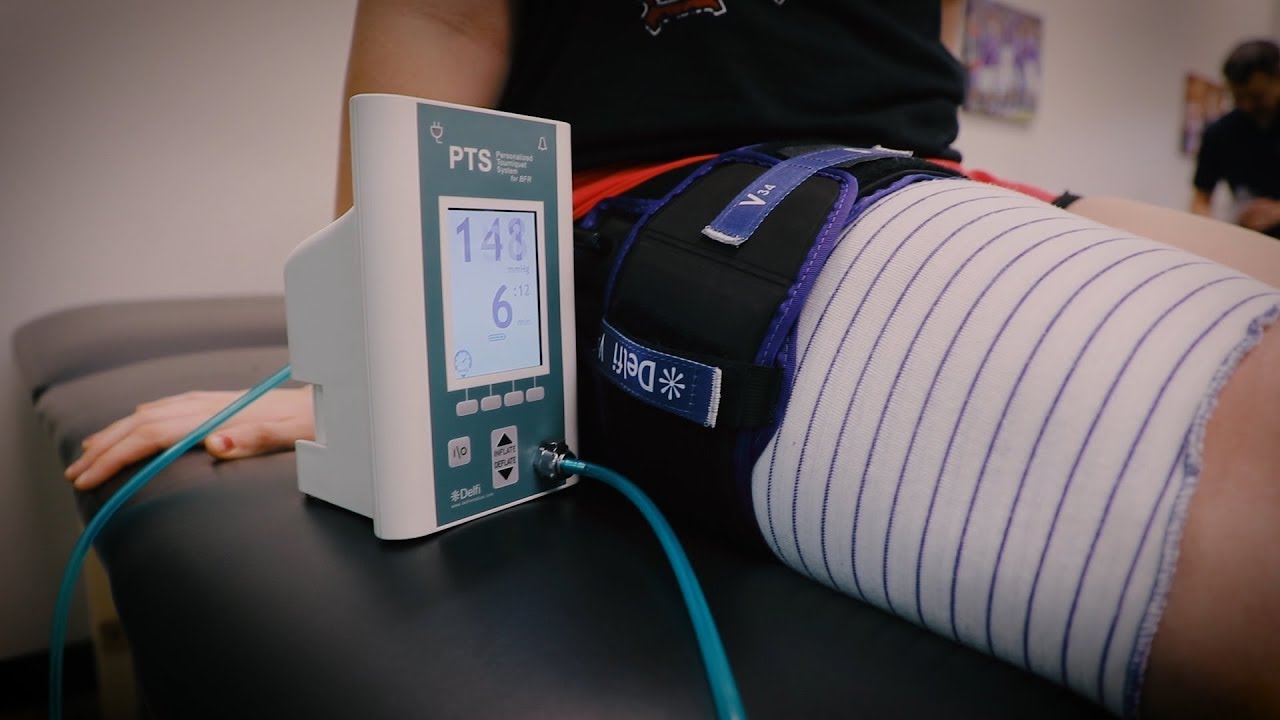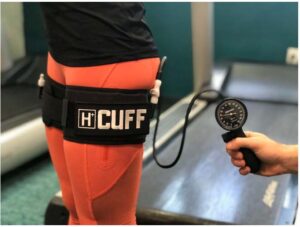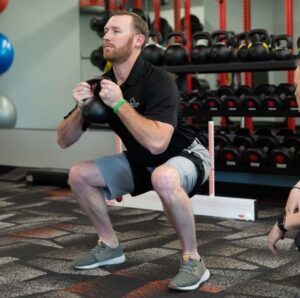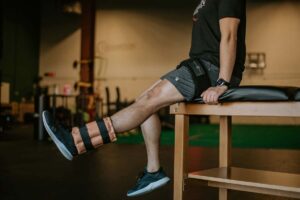
What is Blood Flow Restriction (BFR) Training?
Blood Flow Restriction Training (BFRT) is a form of strength training that uses a tourniquet mechanism to occlude partial blood flow of the main artery to the upper extremity (arm) or lower extremity (leg). Occluding, or partially reducing, blood flow to muscles challenges the body in a way that is metabolically different from traditional strength training.
BFRT was first developed by Dr. Yoshiaki Sato in Japan about 50 years ago.1 He began researching blood flow restriction training in 1966, and conducted early stages of his research on himself. After years of practice, testing and troubleshooting he developed a safe technique for blood flow restriction training. In 1997 he received a patent for KAATSU training and since then it has evolved to be a widely used technique for strength training, muscle hypertrophy and cardiovascular endurance training.¹
Is Blood Flow Restriction Training right for me?
Blood Flow Restriction Training has been shown to decrease muscle wasting, muscle atrophy, improve muscle hypertrophy and can even help to heal fractures faster than conventional treatment approaches alone.²
If you have just recently had an injury or surgery that requires you to modify how you are loading or moving your body, Blood Flow Restriction Training may be a perfect fit for you. In using BFRT, one can strengthen muscles without overloading the joints of the body, or over stressing surgically repaired structures.
With traditional strength training, in order to build muscle mass and muscle strength one must progressively load their bodies with increased weight at the equivalent of 70-100% of their 1 Repetition Maximum (1RM).³ This intensity leads to the utilization of Type II muscle fibers, fast twitch, strength and power muscle fibers. With BFRT, one can see the same recruitment of Type II muscle fibers, with lifting only 20-30% of an individual’s 1RM.3,4,5 This intensity is typically classified as an appropriate load to improve muscular endurance, utilizing Type I, aerobic (oxygen required) slow twitch muscle fibers. By occluding the main artery in the arm or leg, the body’s metabolic processes are altered creating a hypoxic state (without oxygen) in which Type I muscle fibers are quickly fatigued leading to increased recruitment of Type II muscle fibers. What was once an endurance exercise has now become a strengthening and muscle building exercise.
This occlusion also increases the rate of metabolic processes that naturally occur with traditional strength training, including: increase in cell swelling triggering intramuscular anabolic/anti-catabolic signalling, which in turn promotes increased production of growth hormone, insulin-like growth factor (IGF-1), and collagen synthesis leading to the formation of myocytes (new muscle cells), and improved motor unit and muscle fiber recruitment.6,7,8
What are the benefits of Blood Flow Restriction Training?
Blood Flow Restriction Training is easier on the body than traditional resistance training because of the low intensity of exercise. There is evidence that shows muscle damage and microtearing after resistance training with BFR is very minimal and has no prolonged effects on muscle function, including muscle swelling, muscle soreness, or elevation in blood biomarkers indicative of muscle damage.7,9
Consistent with traditional strength training, better and faster results are achieved with BFRT sessions 2-3 times per week.4,5 While muscle hypertrophy may be seen in as little as 6 weeks with BFRT, it may take 8-10 weeks to see true strength gains in a given muscle group.4
In addition to improving muscle strength and hypertrophy, BFRT has also been shown to improve aerobic capacity and VO2 Max.2,4,9,10 reduce amount of muscle atrophy in patients postoperatively and the aging population,2,5,11 and improve rate of bone fracture healing.12

Is Blood Flow Restriction Training Safe?
Temporary tourniquet sight pain, numbness or tingling in the extremity, skin color changes and limb swelling are all considered normal reactions during or after BFRT. While there is a risk of developing subcutaneous hemorrhage (bruising), deterioration of ischemic heart disease, cerebral infarction, rhabdomyolysis, deep vein thrombosis (DVT) or pulmonary embolism (PE), the risk of these occurring in healthy individuals are extremely low.2,5
Talk to your Doctor of Physical Therapy, Orthopedic or Sports Med Physician to decide if BFRT is right for you.
What does Blood Flow Restriction Training look like?
Before beginning Blood Flow Restriction Training, your Physical Therapist will take your blood pressure, and Limb Occlusion Pressure (LOP) of the arm or leg using vascular doppler technology, or in other words, an ultrasound of your artery. The pressure at which the cuff is inflated during exercise is based on this LOP measurement. You will attempt to exercise at 60-80% of this pressure for the lower extremity, or 40-50% for the upper extremity. This LOP measurement will be taken on a monthly basis. Once this has been calculated you begin exercise. Typically 4 sets of each exercise are performed with slow and controlled movements, for one set of 30 reps followed by 3 sets of 15 with 30 seconds of rest between sets.
Fig 1 Obtaining LOP of Radial Artery using doppler

Fig. 2 Inflating to 60-80% LOP

Fig. 3 Squatting with kettlebell, set 1 30reps , sets 2-4 15 reps

Fig 4. Long arc quad exercise, Set 1 30reps , sets 2-4 15 reps

Fig.5 Image of H+ cuff set

References
- Sato, Y. (2005). The history and future of kaatsu training. International Journal of KAATSU Training Research, 1(1), 1–5. https://doi.org/10.3806/ijktr.1.1
- Conceição, M. S., & Ugrinowitsch, C. (2019). Exercise with blood flow RESTRICTION: An effective alternative for the NON‐PHARMACEUTICAL treatment for muscle wasting. Journal of Cachexia, Sarcopenia and Muscle, 10(2), 257–262. https://doi.org/10.1002/jcsm.12397
- Garber CE, Blissmer B, Deschenes MR, Franklin BA, Lamonte MJ, Lee IM, Nieman DC, Swain DP; American College of Sports Medicine. American College of Sports Medicine position stand. Quantity and quality of exercise for developing and maintaining cardiorespiratory, musculoskeletal, and neuromotor fitness in apparently healthy adults: guidance for prescribing exercise. Med Sci Sports Exerc. 2011 Jul;43(7):1334-59. doi: 10.1249/MSS.0b013e318213fefb. PMID: 21694556.
- Loenneke, J. P., Wilson, J. M., Marín, P. J., Zourdos, M. C., & Bemben, M. G. (2011). Low intensity blood flow restriction training: A meta-analysis. European Journal of Applied Physiology, 112(5), 1849–1859. https://doi.org/10.1007/s00421-011-2167-x
- Patterson SD, Hughes L, Warmington S, Burr J, Scott BR, Owens J, Abe T, Nielsen JL, Libardi CA, Laurentino G, Neto GR, Brandner C, Martin-Hernandez J and Loenneke J (2019) Blood Flow Restriction Exercise Position Stand: Considerations of Methodology, Application, and Safety. Front. Physiol. 10:533. doi: 10.3389/fphys.2019.00533
- Charles, D., White, R., Reyes, C., & Palmer, D. (2020). A systematic review of the effects of blood flow restriction training On quadriceps muscle atrophy and circumference post ACL reconstruction. International Journal of Sports Physical Therapy, 15(6), 882–891. https://doi.org/10.26603/ijspt20200882
- Rossi FE, de Freitas MC, Zanchi NE, Lira FS and Cholewa JM (2018) The Role of Inflammation and Immune Cells in Blood Flow Restriction Training Adaptation: A Review. Front. Physiol. 9:1376. doi: 10.3389/fphys.2018.01376
- Scott, B. R., Loenneke, J. P., Slattery, K. M., & Dascombe, B. J. (2014). Exercise with blood flow restriction: An updated evidence-based approach for enhanced muscular development. Sports Medicine, 45(3), 313–325. https://doi.org/10.1007/s40279-014-0288-1
- Abe T, Fujita S, Nakajima T, et al. Effects of Low-Intensity Cycle Training with Restricted Leg Blood Flow on Thigh Muscle Volume and VO2MAX in Young Men. Journal of Sports Science & Medicine. 2010 ;9(3):452-458. PMID: 24149640; PMCID: PMC3761718.
- Bennett, H., & Slattery, F. (2019). Effects of blood flow restriction training on aerobic capacity and performance: A systematic review. Journal of Strength and Conditioning Research, 33(2), 572–583. https://doi.org/10.1519/jsc.0000000000002963
- Centner C, Wiegel P, Gollhofer A, König D. Correction to: Effects of Blood Flow Restriction Training on Muscular Strength and Hypertrophy in Older Individuals: A Systematic Review and Meta-Analysis. Sports Med. 2019 Jan;49(1):109-111. doi: 10.1007/s40279-018-1013-2. Erratum for: Sports Med. 2019 Jan;49(1):95-108. PMID: 30414044; PMCID: PMC6828275.
- Bittar ST, Pfeiffer PS, Santos HH, Cirilo-Sousa MS. Effects of blood flow restriction exercises on bone metabolism: a systematic review. Clin Physiol Funct Imaging. 2018 Mar 2. doi: 10.1111/cpf.12512. Epub ahead of print. PMID: 29498472.
- Hughes, L., Paton, B., Rosenblatt, B., Gissane, C., & Patterson, S. D. (2017). Blood flow restriction training in clinical musculoskeletal rehabilitation: A systematic review and meta-analysis. British Journal of Sports Medicine, 51(13), 1003–1011. https://doi.org/10.1136/bjsports-2016-097071
Danielle Fredricks, DPT

This post was written by Dr. Danielle Fredricks in August of 2021. Danielle is BFR certified.
Learn more about Danielle on our about page: https://gopt.co/about/